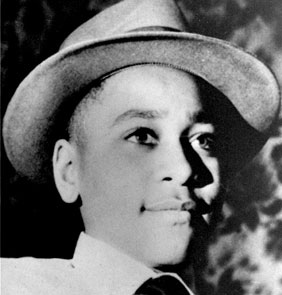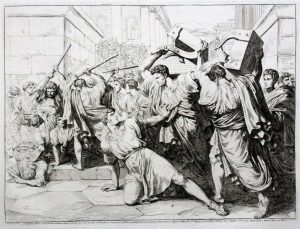Imagine sending your son to visit relatives, thinking you would see him again in a few weeks, only to learn two weeks later that he was murdered. Emmett Louis Till was born in Chicago, Illinois on July 25, 1941 to working class parents.1 His parents, both from the south, met in Argo, Illinois.2 Emmett sadly grew up without his father, after the Army executed him for raping two women and murdering a third in Italy. To add to this already hard life, Emmett got polio at a young age. Although he survived, he was left with a stutter. At school he was known as risk-taker, and he was also described as very outgoing. During the summer of 1955, Emmett’s mother sent him when he was only fourteen years old to Mississippi to visit some relatives, not knowing that she would never see her son alive again.3
Life in the south was much different than life was like where Emmett was from. He did not act the same way his cousins did around white storeowners. He talked freely about his girlfriend back home who was a white woman. One night, after a week in Mississippi, Emmett and seven other teenagers drove to a nearby town to hang out. While they were there, they went to the local grocery store owned by a white couple, Roy and Carolyn Bryant. Roy Bryant was away on a trip, and Carolyn was left in charge of the store. Several accounts exist of the events that happened next, but what is thought to have happened is the boys dared Emmett to go inside the store and ask Carolyn Bryant on a date. It is said that he went inside, bought a pack of gum, then grabbed her hand and asked her on a date. Immediately after this, she pulled away and ran into the back of the store to get a gun. During the time where she went into the back, Emmett’s cousins, realizing what had just happened, ran into the store and pulled Emmett out. As the teenagers were leaving, Emmett allegedly whistled at her and possibly even said, “bye baby!”4

After returning from his trip and finding out what had happened, Roy Bryant and his half-brother J.W. Milam went out to seek revenge. They arrived at the house of Moses Wright, Emmett’s uncle, late Saturday night, both armed with pistols. They stormed the house, ripped Emmett out from his bed, and drove off with him. His uncle pled with them, explaining Emmett was from the north and didn’t know any better, but the men refused to listen. They drove to Milam’s home where they tortured Emmett and mutilated his body. Then they took him to the Tallahatchie River where they forced him to take off all his clothes, shot him, then tied a metal fan to his body and rolled it into the river. Wright reported the kidnapping to the local sheriff the next morning, and by noon, police arrested the two men. They confessed to kidnapping him but claimed that they had let him go. Three days later, fishermen found Emmett’s body floating in the river.5
Mamie Till insisted on having Emmett’s body returned to Chicago so that she could have a funeral for him. She had an open-casket funeral so that everyone would see what had been done to her son. News of this spread immediately and caused an outbreak of protests. In Harlem, an estimated 20,000 people rallied to demand that Congress pass an anti-lynching bill.6
The trial of Roy Bryant and J.W. Milam began on September 19, 1955. Because African-Americans, and women were not allowed to serve as jurors in Mississippi, the jury was all white and all male. After four days of testimony, the jury acquitted Bryant and Milam of all charges. The two later confessed to the murder in an interview, but because of double jeopardy they were not able to be prosecuted.7
Following the news of the trial, thousands of outraged people spoke out. People began to realize that even after Brown v. Board of Education, there was still so much more that needed to be done. Citizens sent letters to their congressmen and the White House, newspapers editorials bashed the jury’s decision, and the number of people in the NAACP expanded greatly. Mamie Till spoke out on multiple occasions about the injustice that her son received. She told people to remember what happened to him and to continue fighting for justice. In addition, popular artists at the time including Gwendolyn Brooks, Toni Morrison, James Baldwin, and Bob Dylan used their own talents to create works dedicated to the Emmett and his case.8
In 2004, the FBI reopened the case. This investigation lasted three years, and during it they exhumed Till’s body to do a complete autopsy. The autopsy did not lead to any criminal charges, but it did lead to Milam’s brother confessing on his deathbed about his own involvement in the kidnapping. Till’s body was put in a new casket and his old casket was later donated to the Smithsonian’s National Museum of African American History and Culture.9
In 2008, a bill was signed into law called the Emmett Till Unsolved Civil Rights Crime Act, which provided funding to “reinvestigate crimes against civil rights workers and their allies.”10 Till’s name continues to remain in our nation’s memory, specifically through the statue of him and Dr. Martin Luther King, Jr. in Denver’s City Park, and in the Emmett Till Players that his mother formed in Chicago. Even today, his case is still being looked at. It was reopened in 2018 due to the publication of a book containing a confession from Carolyn Bryant that states she lied in her testimony during the trial.11 Even though the men who did this to Emmett Till got away with it, the nation is still fighting to get him the justice he deserves. No matter how long ago something occurred, it is never too late to seek justice.
- Encyclopedia Britannica, 2018, s.v. “Emmett Till,” by Michael Ray. ↵
- Simeon Wright and Herb Boyd, Simeon’s Story: An Eyewitness Account of the Kidnapping of Emmett Till (Chicago: Chicago Review Press, 2010), 14. ↵
- James J. Podesta, “Till, Emmett 1941-1955,” Contemporary Black Biography 7 (1994): 262-266. ↵
- James J. Podesta, “Till, Emmett 1941-1955,” Contemporary Black Biography 7 (1994): 262-266. ↵
- James J. Podesta, “Till, Emmett 1941-1955,” Contemporary Black Biography 7 (1994): 262-266. ↵
- James J. Podesta, “Till, Emmett 1941-1955,” Contemporary Black Biography 7 (1994): 262-266. ↵
- Encyclopedia Britannica, 2018, s.v. “Emmett Till,” by Michael Ray. ↵
- Salem Press Biological Encyclopedia, 2014, s.v. “Emmett Till,” by Catherine R Squires. ↵
- Encyclopedia Britannica, 2018, s.v. “Emmett Till,” by Michael Ray. ↵
- Salem Press Biological Encyclopedia, 2014, s.v. “Emmett Till,” by Catherine R Squires. ↵
- Salem Press Biological Encyclopedia, 2014, s.v. “Emmett Till,” by Catherine R Squires. ↵



49 comments
Sydney Hardeman
I remember first learning about Emmett Till’s story and it is one that always triggers me and makes me emotional. For whistling at a white woman he was brutality murdered. The details of his murder are horrifying and effectively displays the amount of racism that has taken place in this country. Thank you for sharing his story. I don’t think Emmett Till’s story should ever stop being told.
Benjamin Pampackal
Emmett Till, is a Civil Rights Icon to all sorts of people. But I believe what he did was not the cause of it, but how he turned out to be after is what really caught this movement on fire. Seeing his mutated face and body at an open casket funeral enraged people of how black men and women were being treated and that fairness and equality was still a long way from where it should be.
Samantha Ruvalcaba
No matter how many times I read about Emmett Till, it always pains me. It’s the brutal reality of how people of color were treated in the South during the 1900s. Icon or not, I’m sure this wasn’t the fat Emmett Till would have imagined nor wanted for himself. I like how you mentioned Emmett’s family’s efforts to find justice. I hope that one day, somehow, they get the justice they’ve been wanting since.
Diamond Davidson
This is one story that makes me wonder why he deserve such torture for something that wasn’t even that serious and for the to get away with it was so wrong. This is a really good article, I just think it should have been a little more descriptive about how they beat him instead of using big words to describe them. However, your article is really good, it just need some touches to it to make it great.
Rosario Moreno
They got away ! They even confessed and got away! Wow the system is brutally unfair. The mom was so brave to have an open casket. That must been so hard for her, but it made others realize how inhumane this was. It made people want to act. I am so saddened that this really did happen, but great article.
Danniella Villarreal
The opening sentence for this article is really good. What those two men did to that young boy was outrageous. There was no need to go as far as kidnapping torturing and killing him. It is sad to know that just because the jury was all white the two men got away and even after they confessed to killing him nothing was done. This was a very interesting and informative article.
Diego Terrazas
It is truly heartbreaking that those murderers got away with it. This article has reminded me again of how far we have come as a country and how we still have racial issues. It is good that they are still investigating the case, although I believe by now the culprits are either dead or near death. This story does a good job of encompassing the dark side of history in America.
Octaviano Huron
Emmett Till’s story is one of the most heartbreaking and gut-wrenching to come from racial injustice. For whistling at a Caucasian woman, a teenage boy was beaten, shot, hanged, and dumped in a river. Roy Bryant and J. W. Milam may have been acquitted for their crimes, but they, along with Carolyn Bryant, had to live with killing a boy and lying to court. I’m glad that his case has re-opened because out of all those under investigation, Emmett Till’s is one of those cases where justice is long overdue.
Maria Garcia
Emmett Till’s story is one that I’ve always found unfair and completely wrong, and this article makes me feel 10 times stronger about that. To read that he was brutally murdered because of a simple whistle and comment is absolutely saddening because if people were to do that in today’s society, a lot of people would get murdered all around the world. It’s sad to read that he never got the justice he or his family deserved because of the jury, but it’s good to know that there are people all over the world fighting for his justice so many years later.
Cameron Lopez
I’ve known of the story of Emmett Till previously and I think it is really an awful thing to read about, such a sad story to hear how he was brutally murdered of a harmless whistle to a white woman. Now that is the story but we may never know what really happened but still they should not of murdered him. I completely forgot that his mother actually insisted on having an open casket funeral which was a bold move on her part I believe. The fact that during trial the jury was nothing but white men and in the time of discrimination it was unfair on the decision of Till’s fate. But now today justice is being served like it should of been back then.